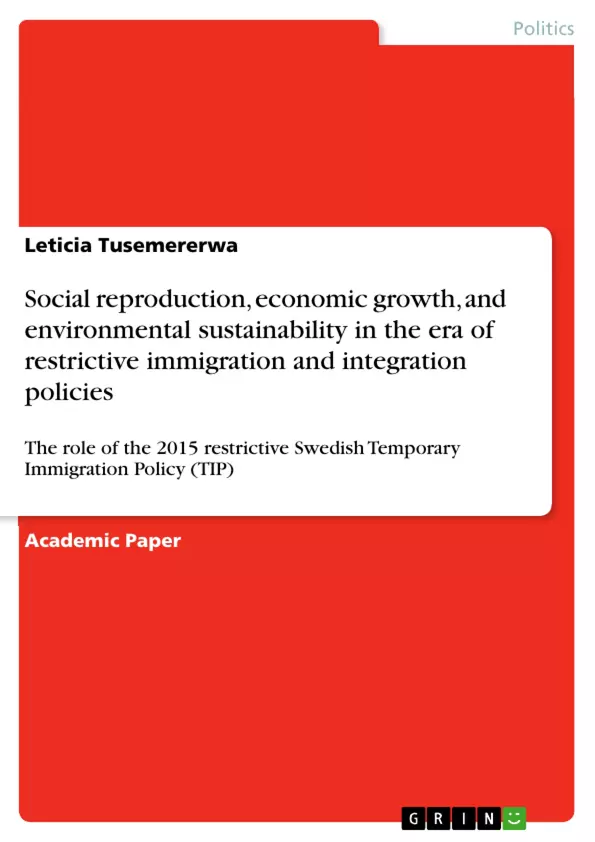The 2015 Swedish restrictive TIP on the limitation to permanent residence permit and family reunification has gained much critics and applauds. Critisms on health, social integration, and labour market participation of actual focus groups, and applauds on its economic boost in terms of reducing strains on the welfare system and number of refugees. The economic and social significances of the policy are evident. Therefore, looking at it through the lens of social reproduction and economic production, and integrating the environment aspect will offer extended insights on the policy issue at hand. However, there is limited research on the 2015 temporary restrictive immigration policies as a form of social integration policy in relation to how they address or not social reproduction and economic production, and the environment thus making it an interesting field to study. This paperwork fills up the gap and introduce immigration and integration as an area of study in social policy and economic performance. Also, focusing on social reproduction in relation to restrictive immigration and integration policy, consents focus and understandings on the question of refugees making, maintenance, production and reproduction abilities within the atmosphere of restrictive immigration and integration policy. Moreover, the paper will contribute with insights on how restrictive immigration and integration policies, as a certain form of social policy, can address or not refugees and immigrant’s social reproduction, boost or not boost economic growth, and impact the environment
Inhaltsverzeichnis (Table of Contents)
- Background
- Introduction
- Policy problem, motivation
- Method, Purpose and research question
- Social policies in Sweden
- Integration social policy in Sweden
- Temporary immigration policy and maintainance requirement in Sweden
- Literature review
- Conceptual and Theoretical framework
- Social Reproduction and human well-being
- Economic growth and the needs of the market
- The theory of the spirit level and environmental sustainability
- Connection of the theories and the studied subject
- Analysis and Discussions
- Impact of TIP through the lens social reproduction and human well-being
- Impacts of the Swedish TIP through the lens of Economic growth
- Impact of the Swedish TIP through the lens of spirit level and environmental sustainability
- Synergies and tensions between social, economy, and environment sustainability in accordance with the swedish TIP
Zielsetzung und Themenschwerpunkte (Objectives and Key Themes)
This paper aims to explore the impacts of the 2015 Swedish Temporary Immigration Policy (TIP) on social reproduction, economic growth, and environmental sustainability. The study focuses on the policy's limitations on permanent residency and family reunification, and the emphasis on the maintenance requirement for refugees. By examining the policy through the lenses of social reproduction, economic growth, and environmental sustainability, the paper seeks to understand the potential synergies and conflicts between these areas.
- The impact of restrictive immigration and integration policies on social reproduction and human well-being of refugees.
- The influence of restrictive immigration and integration policies on economic growth in Sweden.
- The relationship between restrictive immigration and integration policies and environmental sustainability.
- The synergies and tensions between social reproduction, economic growth, and environmental sustainability in the context of the Swedish TIP.
- The role of the state in shaping social reproduction and its consequences for economic production and climate change.
Zusammenfassung der Kapitel (Chapter Summaries)
- Background: This chapter introduces the context of the 2015 Swedish Temporary Immigration Policy (TIP), highlighting its restrictive nature and motivations. It also discusses the Swedish social policy framework, particularly integration policies, and the role of the maintenance requirement within the TIP.
- Literature review: This chapter examines relevant literature concerning the socio-economic consequences of restrictive immigration and integration policies. It draws upon research regarding the impacts of such policies on social reproduction, economic growth, and the environment.
- Conceptual and Theoretical framework: This chapter delves into the theoretical underpinnings of the study. It defines key concepts like social reproduction, economic growth, and environmental sustainability, and explores relevant theories such as Marxian perspectives on social reproduction, Bourdian assumptions on capital accumulation, and the spirit level theory of Wilkinson and Pickett.
- Analysis and Discussions: This chapter analyzes the impacts of the Swedish TIP through the lenses of social reproduction, economic growth, and environmental sustainability. It examines the policy's effects on refugees' well-being, labor market participation, and environmental sustainability.
- Synergies and tensions between social, economy, and environment sustainability in accordance with the swedish TIP: This chapter discusses the potential synergies and conflicts between social, economic, and environmental sustainability in the context of the Swedish TIP. It highlights the challenges in achieving a balance between these areas while considering the needs of refugees.
Schlüsselwörter (Keywords)
This paper focuses on the interplay of social reproduction, economic growth, and environmental sustainability in the context of restrictive immigration and integration policies. It investigates the implications of the 2015 Swedish Temporary Immigration Policy (TIP) on these key areas. The analysis draws upon various theoretical perspectives, including Marxian social reproduction, Bourdian capital accumulation, and Wilkinson and Pickett's spirit level theory, to shed light on the complex dynamics at play.
- Quote paper
- Leticia Tusemererwa (Author), 2019, Social reproduction, economic growth, and environmental sustainability in the era of restrictive immigration and integration policies, Munich, GRIN Verlag, https://www.grin.com/document/504611



